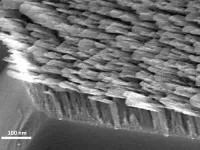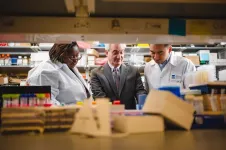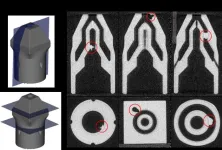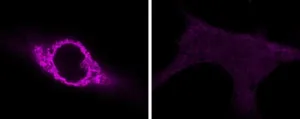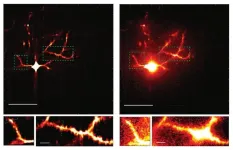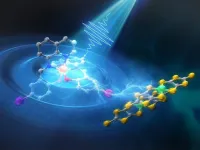(Press-News.org) UNIVERSITY PARK, Pa. — Polarized light waves spin clockwise or counterclockwise as they travel, with one direction behaving differently than the other as it interacts with molecules. This directionality, called chirality or handedness, could provide a way to identify and sort specific molecules for use in biomedicine applications, but researchers have had limited control over the direction of the waves — until now.
Using metamaterials, a team of electrical engineering researchers from Penn State and the University of Nebraska-Lincoln (UNL) created an ultrathin optical element that can control the direction of polarized electromagnetic light waves. This new control allows researchers to not only direct the light’s chirality, but also to identify the chirality of molecules by determining how polarized light interacts with them.
Identifying the chirality of molecules can reveal critical information about how they will interact with other systems, such as whether specific drugs will help heal diseased or damaged tissue without harming healthy cells. The researchers published their findings in Nature Communications.
Chirality refers to mirror images, like left and right hands joining in a handshake, explained Christos Argyropoulos, associate professor of electrical engineering at Penn State and co-corresponding author on the paper. In physics, among other responsibilities, chirality influences the direction that light waves spin.
Argyropoulos and his colleagues fabricated an optical element, akin to a glass slide, that uses a forest of tiny, antenna-like nanorods that together create a metamaterial — or material engineered to have specific properties not typically found in nature — able to control the spin of light. The metamaterial nanorods appear to be shaped like the letter “L” when seen at the nanoscale.
“When the light-matter interaction is mediated by the metamaterials, you can image a molecule and identify its chirality by inspecting how chiral light interacts with it,” Argyropoulos said.
Researchers at UNL used an emerging fabrication approach called glancing angle deposition to fabricate the optical element out of silicon.
“Silicon does not substantially dissipate the incident light that was problematic with metal, which we used in previous attempts to create the element,” said Ufuk Kilic, a research professor at UNL and co-corresponding author on the paper. “And silicon allowed us to adjust the shape and length of the nanopillars on the platform, which in turn allows us to change how we control the light.”
Identifying the chirality of molecules can have wide-ranging impacts in biomedicine, particularly in pharmaceutical drugs, which sometimes have right- or left-handed chirality, Argyropoulos explained. While a right-handed molecular structure can be effective at treating disease, the same molecule with a left-handed structure can be toxic to healthy cells.
Argyropoulos mentioned the classic example of thalidomide, a drug with a chiral structure that was prescribed to women to treat morning sickness between 1957 and 1962. The right-handed molecule could appease nausea but was highly toxic to developing fetuses and caused birth defects for thousands of babies around the world. The optical element, Argyropoulos said, can quickly image the molecular structure of pharmaceuticals, allowing scientists to better understand the nuances of drug behavior.
Additionally, the optical element can be used to create right- or left-handed electromagnetic waves, Argyropoulos said, which are necessary for the development and maintenance of classical and quantum communications systems, like encrypted Wi-Fi and cell phone service.
“Previously, for optical communication systems, you needed big, bulky devices that only operated at one frequency,” Argyropoulos said. “This new optical element is lightweight and easily tunable to multiple frequencies.”
In addition to Argyropoulos and Kilic, the co-authors include Matthew Hilfiker, Shawn Wimer, Alexander Ruder, Eva Schubert and Mathias Schubert, all from UNL.
The U.S. National Science Foundation, the Air Force Office of Scientific Research, the University of Nebraska Foundation and the J.A. Woollam Foundation supported this work.
END
Shining a light on molecules: L-shaped metamaterials can control light direction
Technological advancement enables researchers to identify and sort specific molecules based on how they interact with differently directed light
2024-06-04
ELSE PRESS RELEASES FROM THIS DATE:
Wistar scientists develop novel antibody treatment for kidney cancer
2024-06-04
PHILADELPHIA — (June 04, 2024) — Advanced clear cell renal cell carcinoma (ccRCC) is a deadly form of kidney cancer with few treatment options; even with new immunotherapies, only around one in 10 patients ultimately survive.
Antibody therapies called bispecific T cell engagers (BTEs) have emerged as effective treatments for some blood cancers but have been more difficult to develop for solid tumors. While clinically successful, first-generation BTEs suffer a short half-life. Now, Wistar scientists have built upon BTE technology to develop new and improved recombinant and synthetic ...
Virus that causes COVID-19 can remain in sperm for 110 days after infection
2024-06-04
Researchers at the University of São Paulo (USP) in Brazil have shown for the first time that SARS-CoV-2, the virus that causes COVID-19, can remain in the sperm of patients for up to 90 days after hospital discharge and up to 110 days after the initial infection, reducing semen quality. The study is reported in an article published in the journal Andrology. The authors suggest that people who plan to have children should observe a period of “quarantine” after recovering ...
Researchers use machine learning to detect defects in additive manufacturing
2024-06-04
Researchers at the University of Illinois Urbana-Champaign have developed a new method for detecting defects in additively manufactured components.
One of the most important tasks in any factory is to determine whether a manufactured component is free of defects. In additive manufacturing (3D printing), it can be particularly challenging to find defects, because additive manufacturing can make components that have complex three-dimensional shapes and important internal features that are not easily observed.
The novel technology uses deep machine ...
Rare disease’s DNA-damaging mutation could have consequences for more common conditions
2024-06-04
TREX1 is a gene that is supposed to direct the maintenance of the entire body’s DNA, but new research shows that when people are born with mutated TREX1, it causes catastrophic damage to the DNA over time, resulting in a deadly rare disease called retinal vasculopathy with cerebral leukoencephalopathy (RVCL). Published in Nature Communications, the research was led by teams at the Perelman School of Medicine at the University of Pennsylvania and the Brain Research Institute at Niigata University in Japan.
While it was already known that a mutation in TREX1 was behind RVCL, the mechanism by which ...
Exploring three frontiers in marine biomass and blue carbon capture
2024-06-04
A new study offers first-time insights into three emerging climate innovations to safeguard or increase the carbon naturally captured by ocean and coastal ecosystems: rapid interventions to save the Great Barrier Reef, satellite-tracked kelp beds in the deep ocean, and seagrass nurseries in the United Kingdom. The research, published in Environmental Science & Policy and co-authored by leading climate scholars at Boston University, Aarhus University, and the University of Sussex Business School, advances knowledge of understudied interventions in marine ...
Microscope system sharpens scientists’ view of neural circuit connections
2024-06-04
The brain’s ability to learn comes from “plasticity,” in which neurons constantly edit and remodel the tiny connections called synapses that they make with other neurons to form circuits. To study plasticity, neuroscientists seek to track it at high resolution across whole cells, but plasticity doesn’t wait for slow microscopes to keep pace and brain tissue is notorious for scattering light and making images fuzzy. In a paper in Scientific Reports, a collaboration of MIT engineers and neuroscientists describes a new microscopy system designed for fast, clear, and frequent imaging of the living brain.
The system, ...
VHIO researchers demonstrate the utility of high-sensitivity liquid biopsy to predict and monitor response to immunotherapy
2024-06-04
The liquid biopsy technique applied in this work is based on the sequencing of the entire tumor genome from 138 patients and the monitoring of mutations in the blood. This approach achieves high sensitivity in detecting the tumor signal in the blood (1/1,000,000 DNA molecules), and the patterns found reflect how patients respond to immunotherapy.
This study is part of the Comprehensive Program of Cancer Immunotherapy and Immunology (CAIMI) at VHIO, funded by the BBVA Foundation, and is co-led by Dr Rodrigo Toledo, head of the Biomarkers and Clonal Dynamics Group at the Vall d’Hebron Institute of Oncology (VHIO), ...
Muscle disorder caused by key protein mutations uncovered in new study
2024-06-04
A recent study has found that the SMCHD1 protein plays a key role in controlling how genes are processed, which affects the progression of Facioscapulohumeral Muscular Dystrophy (FSHD). This discovery about SMCHD1's function in gene regulation is important because it opens new possibilities for developing targeted therapeutic strategies to combat the disease. By understanding more about how SMCHD1 works, scientists can explore new ways to fight the disease.
A recent study by MD-PhD student Eden Engal under the guidance of Dr. Yotam Drier and ...
Observing ultrafast photoinduced dynamics in a halogen-bonded supramolecular system
2024-06-04
Researchers uncover how the halogen bond can be exploited to direct sequential dynamics in the multi-functional crystals, offering crucial insights for developing ultrafast-response times for multilevel optical storage.
Halogen bonds are intermolecular interactions that arise from the attraction between a halogen atom (group 17 elements in the periodic table) and another atom with lone pairs, more generally a molecular entity with high electron density. Understanding the distinctive and highly directional nature of halogen bonds is crucial for crystal engineering and studying ...
USPSTF recommendation statement on interventions to prevent falls in community-dwelling older adults
2024-06-04
Bottom Line: The U.S. Preventive Services Task Force (USPSTF) recommends exercise interventions to prevent falls in community-dwelling adults 65 years or older who are at increased risk for falls. The USPSTF recommends that clinicians individualize the decision to offer multifactorial interventions to prevent falls to community-dwelling adults 65 years or older who are at increased risk for falls. Existing evidence indicates that the overall net benefit of routinely offering multifactorial interventions to prevent falls is small. When determining ...
LAST 30 PRESS RELEASES:
Scientists discover a hidden RNA “aging clock” in human sperm
New quantum boundary discovered: Spin size determines how the Kondo effect behaves
Ancient ‘spaghetti’ in dogs’ hearts reveals surprising origins of heartworm
Full value added tax on meat: a first step towards pricing the environmental damages caused by diets
Hidden mpox exposure detected in healthy Nigerian adults, revealing under-recognized transmission
Shingles vaccine linked to slower biological aging in older adults
A self-assembling shortcut to better organic solar cells
A two-week leap in breeding: Antarctic penguins’ striking climate adaptation
Climate risks to insurance and reinsurance of global supply chains
58% of patients affected by 2022 mpox outbreak report lasting physical symptoms
Golden Gate method enables rapid, fully-synthetic engineering of therapeutically relevant bacteriophages
Polar weather on Jupiter and Saturn hints at the planets’ interior details
Socio-environmental movements: key global guardians of biodiversity amid rising violence
Global warming and CO2 emissions 56 million years ago resulted in massive forest fires and soil erosion
Hidden order in quantum chaos: the pseudogap
Exploring why adapting to the environment is more difficult as people age
Society for Laboratory Automation and Screening welcomes new scientific director: Madeline M. Farley, Ph.D.
Austrian cow shows first case of flexible, multi-purpose tool use in cattle
Human nasal passages defend against the common cold and help determine how sick we get
Research alert: Spreading drug costs over the year may ease financial burden for Medicare cancer patients
Hospital partnership improves follow up scans, decreases long term risk after aortic repair
Layered hydrogen silicane for safe, lightweight, and energy-efficient hydrogen carrier
Observing positronium beam as a quantum matter wave for the first time
IEEE study investigates the effects of pointing error on quantum key distribution systems
Analyzing submerged fault structures to predict future earthquakes in Türkiye
Quantum ‘alchemy’ made feasible with excitons
‘Revoice’ device gives stroke patients their voice back
USF-led study: AI helps reveal global surge in floating algae
New method predicts asthma attacks up to five years in advance
Researchers publish first ever structural engineering manual for bamboo
[Press-News.org] Shining a light on molecules: L-shaped metamaterials can control light directionTechnological advancement enables researchers to identify and sort specific molecules based on how they interact with differently directed light
